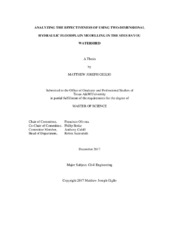| dc.description.abstract | With the widespread availability of two-dimensional (2D) hydraulic modelling, it is important to understand its potential advantages over currently accepted one-dimensional (1D) hydraulic models to further the disaster resiliency of communities in the future and more accurately predict the FEMA floodplain extents. Hydrologic Engineering Center – River Analysis System (HEC-RAS) 4.1 and 5.0.3 were selected as the 1D and 2D computational models, respectively, to compare their generation of the 100-year floodplain and the 10-year floodplain. A large and small storm were selected as inputs to identify any advantages of using one model or another based upon the size of the storm. The study was conducted in Sims Bayou Watershed of Houston, Texas.
1D HEC-RAS 4.1 models were downloaded for free from the Harris County Flood Control District (HCFCD) while the 2D model was created using the best available data closest to the development of the 1D models and implemented rain-on-grid where precipitation was applied directly to the 2D computational area. Inundation boundary maps, maximum water depth maps, and maximum velocity maps were created for both storms using both modelling methods.
The 2D model yielded inundation areas that covered over 40 square miles more than the 1D model inundated areas for the same storm. When values below one foot were removed from the 2D model’s maximum depth, the floodplain became more similar to the 1D inundation map. However, there were several locations outside of the 1D floodplain with over a one foot depth of water in the 2D model, especially for the larger 100-year storm. Therefore, the 2D model revealed areas not designated in current 1D floodplains where potential flood waters could threaten a community. However, the 2D model lacked the capability of modelling bridges that the 1D model contained; therefore, resulting in higher flow velocities in downstream areas of the watershed in the 2D model. This appeared though to have a minimal effect on the floodplain extents. Using 2D models to observe flood water propagations both during the river channel water collection and eventual channel overflow is important in understanding the disaster resiliency and vulnerability of the communities in the area; however, would be unnecessary for modelling smaller floods as the benefit of the 2D modelling of the floodplain would decrease. | en |


